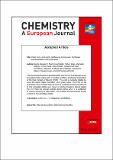Files in this item
Chiral AuI- and AuIII-isothiourea complexes : synthesis, characterization and application
Item metadata
| dc.contributor.author | Gasperini, Danila | |
| dc.contributor.author | Greenhalgh, Mark | |
| dc.contributor.author | Imad, Rehan | |
| dc.contributor.author | Siddiqui, Shehzaib | |
| dc.contributor.author | Malik, Anum | |
| dc.contributor.author | Arshad, Fizza | |
| dc.contributor.author | Choudhary, Muhammad Iqbal | |
| dc.contributor.author | Al-Majid, Abdullah | |
| dc.contributor.author | Cordes, David | |
| dc.contributor.author | Slawin, Alexandra | |
| dc.contributor.author | Nolan, Steven | |
| dc.contributor.author | Smith, Andrew D. | |
| dc.date.accessioned | 2019-12-21T00:36:25Z | |
| dc.date.available | 2019-12-21T00:36:25Z | |
| dc.date.issued | 2018-12-21 | |
| dc.identifier | 256369559 | |
| dc.identifier | b69c546f-1f87-4734-bde7-46d677c5d802 | |
| dc.identifier | 85059011049 | |
| dc.identifier | 000456318800025 | |
| dc.identifier.citation | Gasperini , D , Greenhalgh , M , Imad , R , Siddiqui , S , Malik , A , Arshad , F , Choudhary , M I , Al-Majid , A , Cordes , D , Slawin , A , Nolan , S & Smith , A D 2018 , ' Chiral Au I - and Au III -isothiourea complexes : synthesis, characterization and application ' , Chemistry - A European Journal , vol. Early View . https://doi.org/10.1002/chem.201804653 | en |
| dc.identifier.issn | 0947-6539 | |
| dc.identifier.other | ORCID: /0000-0002-2104-7313/work/52572453 | |
| dc.identifier.other | ORCID: /0000-0002-5366-9168/work/52572467 | |
| dc.identifier.other | ORCID: /0000-0002-9527-6418/work/56861419 | |
| dc.identifier.uri | https://hdl.handle.net/10023/19187 | |
| dc.description | ADS thanks the Royal Society for a Wolfson Research Merit Award. We also thank the EPSRC UK National Mass Spectrometry Facility at Swansea University. SPN thanks King Abdullah University of Science and Technology (Award No. SR-2015-CCF-1974-03) and King Saud University for support. | en |
| dc.description.abstract | During an investigation into the potential union of Lewis basic isothiourea organocatalysis and gold catalysis, the formation of gold‐isothiourea complexes was observed. These novel gold complexes were formed in high yield and were found to be air‐ and moisture stable. A series of neutral and cationic chiral gold(I) and gold(III) complexes bearing enantiopure isothiourea ligands was therefore synthesized and fully characterized. The steric and electronic properties of the isothiourea ligands was assessed through calculation of their percent buried volume and the synthesis and analysis of novel iridium(I)‐isothiourea carbonyl complexes. The novel gold(I)‐ and gold(III)‐isothiourea complexes have been applied in preliminary catalytic and biological studies, and display promising preliminary levels of catalytic activity and potency towards cancerous cell lines and clinically‐relevant enzymes. | |
| dc.format.extent | 1985948 | |
| dc.language.iso | eng | |
| dc.relation.ispartof | Chemistry - A European Journal | en |
| dc.subject | Gold | en |
| dc.subject | Coordination chemistry | en |
| dc.subject | N ligands | en |
| dc.subject | Homogeneous catalysis | en |
| dc.subject | Bioinorganic chemistry | en |
| dc.subject | QD Chemistry | en |
| dc.subject | DAS | en |
| dc.subject | SDG 3 - Good Health and Well-being | en |
| dc.subject.lcc | QD | en |
| dc.title | Chiral AuI- and AuIII-isothiourea complexes : synthesis, characterization and application | en |
| dc.type | Journal article | en |
| dc.contributor.sponsor | The Royal Society | en |
| dc.contributor.institution | University of St Andrews. School of Chemistry | en |
| dc.contributor.institution | University of St Andrews. EaSTCHEM | en |
| dc.contributor.institution | University of St Andrews. Biomedical Sciences Research Complex | en |
| dc.identifier.doi | https://doi.org/10.1002/chem.201804653 | |
| dc.description.status | Peer reviewed | en |
| dc.date.embargoedUntil | 2019-12-21 | |
| dc.identifier.grantnumber | WM140071 | en |
This item appears in the following Collection(s)
Items in the St Andrews Research Repository are protected by copyright, with all rights reserved, unless otherwise indicated.

